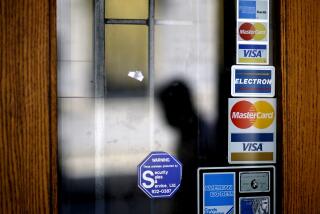Credit Card Delinquencies Drop to Three-Year Low
- Share via
Confident that the growing economy will keep their jobs secure, American consumers continue to charge up a storm. But a growing number are also mailing their payments sooner, or even paying off their balances.
A persistently growing economy has increased employment, and card issuers say they have tightened lending standards, resulting in the lowest level of delinquent credit card accounts since the fall of 1994, the American Bankers Assn. said Tuesday.
The ABA reported that the number of accounts 30 or more days delinquent fell to 3.04% in the fourth quarter, down from 3.53% in the third quarter and down from a record high of 3.72% in the fourth quarter of 1996.
“After a long cold spell of rising delinquencies, this is the first sign of a spring thaw,” said James Chessen, chief economist for the ABA. “The combination of cautious lending and consumer education by banks, as well as consumer restraint and the strong economy, helped curb delinquencies.”
Since 1995, lenders have reported that they have trimmed overdue credit debts on their books by raising fees for late payments, making more frequent credit checks and lowering credit limits for delinquent customers.
Banks have also been less aggressive in lending money to consumers since a surge in personal bankruptcies that was blamed in part on credit card debt, according to the Federal Reserve Board’s periodic survey of senior bank loan officers.
Even so, because of the rise in bankruptcies, “we’ll probably continue to see the delinquency numbers remain higher that we would expect in a strong economy,” Chessen said.
Credit counselors agree that more people are able to pay their bills on time. But they do not believe it is because they are taking on less debt.
Carol Kurth, education coordinator for Credit Counseling Centers Inc. in Farmington Hills, Mich., thinks families don’t have less debt but are simply trading in one type of debt for another.
For example, many more people are taking out home equity loans, sometimes for 125% of the house’s value, to pay off their credit cards. “People are not getting rid of debt, they’re changing how they’re paying for it,” she said.
Robert W. Morley, general manager of Credit Counseling Centers of America in Dallas, said the improvement could evaporate if the economy sours.
“In our experience over the last decade, people generally don’t change their lifestyle unless they have to,” he said.
“If they’re downsized, they continue to spend at the same rate and put it on their credit card. A lot of people just still treat credit cards like money, and I don’t really see that changing.”
Banks are declaring less money on credit cards as uncollectable, according to Standard & Poor’s Corp. Also, consumers repaid a record portion of their outstanding credit card debt in January, according to a survey by Moody’s Investors Services.
But the credit picture is not uniformly improved. Credit card balances are rising, and the ABA noted that delinquencies rose as a percentage of the dollar amount of charges outstanding.
And consumers are still turning to bankruptcy in record numbers, sometimes without even falling behind in their credit payments, lenders have said. In 1997, 1.35 million people filed for personal bankruptcy, up from 1.13 million in 1996, according to the Administrative Office of the U.S. Courts.
More to Read
Sign up for Essential California
The most important California stories and recommendations in your inbox every morning.
You may occasionally receive promotional content from the Los Angeles Times.













